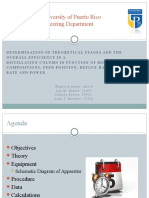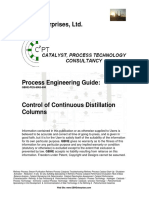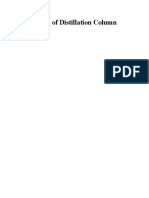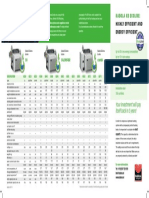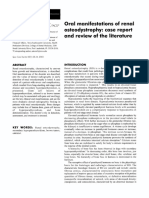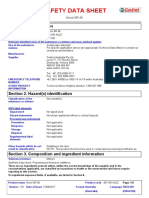Pap (Design of Distillation Column)
Pap (Design of Distillation Column)
Uploaded by
MambaulkCopyright:
Available Formats
Pap (Design of Distillation Column)
Pap (Design of Distillation Column)
Uploaded by
MambaulkOriginal Description:
Copyright
Available Formats
Share this document
Did you find this document useful?
Is this content inappropriate?
Copyright:
Available Formats
Pap (Design of Distillation Column)
Pap (Design of Distillation Column)
Uploaded by
MambaulkCopyright:
Available Formats
PROCESS EQUIPMENT DESIGN
Design of Distillation Column
Types of Column
Based on number of stages:
1 stage: flash distillation, to separate components that have
far difference in volatility; usually held in the beginning step
-
Cascade distillation = multi stage distillation, the column
has more than 1 stage
Based on process continuity:
Batch distillation
Continuous distillation
Design of Flash Distillation
Design equation:
F .z i
L Li
V
1 Ki
Or:
F .z i
V Vi
1 L
1
Ki V
Design of Flash Distillation
Principles in design of flash distillation:
If P, T are designed, then V, L along with their
compositions are calculated
If P and one of products are designed, then T and the
other product are calculated
If T and one of products are designed, then P and the
other product are calculated
Design of Cascade Distillation
Design of Sequence
Number of sequences:
Ns
2 N 1 .!
N !. N 1.!
Optimum sequence if the total amount of vapor produced is
minimum.
The amount of vapor produced in each column can be
predicted using Smiths equation:
Rf
V DF
1
Design of Cascade Distillation
Design of Sequence
Determination of optimum sequence using empirical
method:
A pair of components having close relative volatility
(approaching to 1) or azeotrope is separated at the
end; or Components having the highest relative
volatility are separated first
The lightest component is separated first
The component having the highest amount in the
feed is separated first
The separation is attempted to be a near-equimolar
split
Design of Cascade Distillation
Design of Component Distribution
Types of components
Key components: light component (LK), the
component that becomes separation target and is
dominant in the top product; heavy component (HK),
dominant in the bottom product
Distributed components: the components the exist in
both top and bottom products; the key components are
always distributed components
Non-distributed component: only exist in one of
products
Design of Cascade Distillation
Design of Operating Conditions
Top Operating Conditions
By considering the following issues:
Data of critical points (especially critical temperature &
pressure)
Tc , mix xi .Tc ,i
The top operating temperature << Tc,mix in order that the
vapor is easy to condense
Property of azeotropic solution
The composition of top product cannot exceed the
azeotropic composition
Design of Cascade Distillation
Design of Operating Conditions
Top Operating Conditions
By considering the following issues:
Site plant condition (the condition of cooling utilities
surrounding the plant)
Ttop Tcm Tapproach
Design of Cascade Distillation
Design of Operating Conditions
Top Operating Condition
Total condenser is the first option to use; if the operating
pressure is too high, then use partial condenser
Total condenser (all vapor condenses into liquid):
If T is designed, then P is calculated:
P
xi .Pio
Using Raoults eqn.
yi
K i .x i 1
Using bubble point eqn.
If P is designed, then T is calculated:
Using bubble point eqn.
Design of Cascade Distillation
Design of Operating Conditions
Top Operating Condition
If partial condenser is used:
If T is designed, then P is calculated:
Using dew point eqn.
x yi / K
i
If P designed, then T is calculated:
Using dew point eqn.
Design of Cascade Distillation
Design of Operating Conditions
Bottom Operating Conditions
If the top operating conditions have been designed, the bottom P
can be determined from:
Assumption that P is constant or no pressure drop along the
column, or
If there is pressure drop, then P bottom = P top + pressure
drop (bottom P > top P)
T bottom is then calculated using bubble point
K i .x i 1
In principle, the design of operating conditions of column can be
started from the bottom site, then to the top site
Design of Cascade Distillation
Design of Columns Dimension
The main dimensions of distillation column include: height (H)
and diameter (D)
Height of Column
The height of column is determined from:
Actual number of plates (Nact)
Tray spacing designed (t)
Space provided in the top and bottom heads (a, b)
H a ( Nact 1).t b
Design of Cascade Distillation
Design of Columns Dimension
The actual number of plates is correlated from the number of
theoretical equilibrium plates (N) and plate efficiency (Eff), as
Follows:
Nact N / Eff
Plate efficiency shows that in one plate the liquid and vapor are
not exactly at equilibrium.
The number of theoretical equilibrium plates can be estimated by
Graphical method (Mc Cabe Thiele, etc.)
Short cut method (Fenske-Underwood-Gilliland, etc.)
Plate to plate calculation
Design of Cascade Distillation
Design of Columns Dimension
Graphical method needs:
Graph of mole fractions of vapor (y) vs that of liquid (x)
Equilibrium curve, the correlation y vs x at equilibrium stage
Operating lines of enriching and rectifying sections
Feed and product compositions
Design of Cascade Distillation
Design of Columns Dimension
Short cut method:
Fenske Underwood Gilliland
Fenske
Fenske eqn. is used to estimate the minimum number of plates
(Nm). It works at total reflux, which is not applied in practice
Underwood
Underwood eqn. is used to estimate the minimum reflux ration
(Rm). At minimum reflux ration, it needs infinite number of
plates to produce given compositions of products.
In practice the distillation operates at R = (1.2 1.5) x Rm
Design of Cascade Distillation
Design of Columns Dimension
Feed Plate:
The position of feed plate may be predicted from Kirkbride eqn.,
as follows
N
log r
Ns
B
0.206 log
x
. Hk
x LK
x
. LK , B
F x HK , D
Design of Cascade Distillation
Design of Columns Dimension
Plate to plate calculation:
Assumption: steady state, liquid and vapor are at equilibrium,
constant molar overflow, constant heat of vaporization.
Plate to plate calculation may start from either top or bottom site.
In principle, the calculation is stopped when the plate
composition is similar to that of feed composition.
Design of Cascade Distillation
Design of Columns Dimension
Enriching Section:
Mass balance from the top site to the plate n,
Total mass balance:
Vn 1 Ln D
Mass balance of component i:
Or,
Vn 1 . y i ,n 1 Ln .xi ,n D.xi , D
1
The compositions of vapor
the following
is calculated
y i ,n 1in
( Ln .plate
xi , n
D.xi , D ) from the compositions of
Vn 1those of distillate
liquid in the previous plate and
Design of Cascade Distillation
Design of Columns Dimension
Enriching Section:
For constant molar overflow, Vn+1 = Vn = V
Ln = Ln-1 = Ln+1 = L
Then,
yi , n 1
1
( L.xi , n D.xi , D )
V
In term of reflux ratio:
y i ,n 1
R
1
xi ,n
xi , D
R 1
R 1
Design of Cascade Distillation
Design of Columns Dimension
Enriching Section:
To determine the compositions of liquid which are equilibrium with
those of vapor at the same plate, dew point equation is used,
as follows
i , n 1
The calculation stops when
yi , n 1
x HK
x LK
i , n 1
calc .
x HK
x LK
feed
Design of Cascade Distillation
Design of Columns Dimension
Stripping Section:
Mass balance from the bottom site to the plate m,
Total mass balance:
Mass balance of component i:
Or,
L'm1 V 'm B
1
(V 'm . yplate
.xi , B ) from the
The compositions ofxliquid
in the following
i , m 1
i , m isBcalculated
'm previous
compositions of vapor inLthe
plate and those of bottom product
1
Design of Cascade Distillation
Design of Columns Dimension
Stripping Section:
For constant molar overflow, Vn+1 = Vn = V
Ln = Ln-1 = Ln+1 = L
Then,
xi ,m 1
1
(V '.yi ,m B.xi , B )
L'
To determine the compositions of vapor which are equilibrium with those of
liquid at the same plate, bubble point equation is used, as follows
The calculation stops when
i , m 1
K i ,m 1.xi ,m 1 1
xHK
xLK
calc .
xHK
xLK
feed
Design of Cascade Distillation
Design of Columns Dimension
Plate Efficiency:
Correlation OConnell
Eo 51 32,5. log a . a
a = average viscosity of liquid, mN.s/m2
a = average relative volatility of LK
Another empirical correlation;
Eo 17 61.1.1og a , F
The plate efficiency may be roughly estimated by 70%
Design of Cascade Distillation
Design of Columns Dimension (Diameter)
By Souders, Brown, and Lowenstein:
Dcmin
4VW
. v .uv
2
u v 0,171lt 0,27lt 0,047
Vw [=] kg/s ; lt [=] m ; uv [=] m/s ; [=] kg/m3
L V
V
Design of Cascade Distillation
Design of Columns Dimension (Diameter)
By Fair:
4 An
4.VW
Dc
.(1 p )
.(1 p ). v .uv
u f K1
L V
K1 f ( FLV , lt , )
You might also like
- Aldehyde Ketone Nucleophilic AdditionDocument72 pagesAldehyde Ketone Nucleophilic AdditionMambaulkNo ratings yet
- Explanatorium of NatureDocument362 pagesExplanatorium of NatureMaria Cobos100% (9)
- Methanol PresentationDocument29 pagesMethanol Presentationافكر اشتري كورياNo ratings yet
- Spheripol AdDocument30 pagesSpheripol Adjahsmine TristanNo ratings yet
- Distillation PresentationDocument61 pagesDistillation PresentationAli AmjadNo ratings yet
- Lab ManualDocument59 pagesLab ManualmarkNo ratings yet
- Catalytic Conversion Processes - Cont'd: AlkylationDocument13 pagesCatalytic Conversion Processes - Cont'd: AlkylationHina IbrahimNo ratings yet
- LECTURE - 4: ChloromethaneDocument4 pagesLECTURE - 4: Chloromethaneمحمود محمدNo ratings yet
- Interview Questions For Chemical EngineeringDocument6 pagesInterview Questions For Chemical EngineeringNikunj PatelNo ratings yet
- Distillation Column PDFDocument74 pagesDistillation Column PDFAsad KhanNo ratings yet
- DCC EngDocument1 pageDCC Engwahaha06No ratings yet
- 2.4 Manufacturing Process: Chlorination of MethaneDocument6 pages2.4 Manufacturing Process: Chlorination of MethaneAnonymous XSuXpopx0QNo ratings yet
- Tower Tray Oil and Gas IndustryDocument11 pagesTower Tray Oil and Gas IndustryHeet PatelNo ratings yet
- ENGINEERING DESIGN GUIDELINES Distillation Column Rev4.2web PDFDocument23 pagesENGINEERING DESIGN GUIDELINES Distillation Column Rev4.2web PDFMohsen KadivarNo ratings yet
- Exp 1 - CSTR DynamicDocument20 pagesExp 1 - CSTR Dynamicjychong0% (1)
- Unit 3 Overview of CDU and VDUDocument38 pagesUnit 3 Overview of CDU and VDU22 shantanu kapadnisNo ratings yet
- Hydro CrackingDocument25 pagesHydro CrackingBharat KumarNo ratings yet
- 39 Algal Oil Production 1Document21 pages39 Algal Oil Production 1Sai Srivathsava UdathuNo ratings yet
- Distillation Column Selection, Sizing and Troubleshooting, Kolmetz Handbook of Process Equipment DesignDocument24 pagesDistillation Column Selection, Sizing and Troubleshooting, Kolmetz Handbook of Process Equipment DesignGilles DakouriNo ratings yet
- Petrochemical UnitDocument1 pagePetrochemical UnitrezamzaNo ratings yet
- P&id DescriptionDocument7 pagesP&id DescriptionMark Guevarra100% (2)
- Crude Oil Refining (Crude Oil DistillationDocument12 pagesCrude Oil Refining (Crude Oil Distillationشيبوب shaibobNo ratings yet
- Zahid Ali: - Refinery LimitedDocument50 pagesZahid Ali: - Refinery Limitedzahid aliNo ratings yet
- Hot High Pressure SeparatorDocument2 pagesHot High Pressure SeparatorKhai NguyenNo ratings yet
- JERP Brief ProcessDocument14 pagesJERP Brief Processbikas_sahaNo ratings yet
- Anone PlantDocument2 pagesAnone PlantAbijith100% (1)
- Catalytic Reforming Unit (Cru)Document20 pagesCatalytic Reforming Unit (Cru)Ashish RajakNo ratings yet
- Energy Engineering-Lab Manuals PDFDocument82 pagesEnergy Engineering-Lab Manuals PDFUzair ArslanNo ratings yet
- Interview Questions .Document9 pagesInterview Questions .Shyam Sundar KannanNo ratings yet
- 5 Oil Refinery ProcessesDocument111 pages5 Oil Refinery ProcessesMohamed Sayed AbdoNo ratings yet
- L - 17 Catalyst Deactivation: Prof. K.K.Pant Department of Chemical Engineering IIT DelhiDocument23 pagesL - 17 Catalyst Deactivation: Prof. K.K.Pant Department of Chemical Engineering IIT DelhiMehul VarshneyNo ratings yet
- ChE 407 Lecture 1Document75 pagesChE 407 Lecture 1Design Group0% (1)
- Nptel Lecture Notes 2Document21 pagesNptel Lecture Notes 2balusappsNo ratings yet
- Crude Distillation UnitDocument2 pagesCrude Distillation Unitresure100% (1)
- Distillation ColumnDocument32 pagesDistillation ColumnTatiana RosarioNo ratings yet
- (1)Document119 pages(1)Virginia Rosales OlmosNo ratings yet
- Dehydration of Natural GasDocument9 pagesDehydration of Natural GasHuda ShahNo ratings yet
- Gas Concentration Unit WorkpaperDocument11 pagesGas Concentration Unit WorkpaperMohammad Haseeb Azam100% (1)
- UcucucDocument97 pagesUcucucJV Custodio100% (2)
- Process Design of Distillation ColumnDocument22 pagesProcess Design of Distillation ColumnUzair WahidNo ratings yet
- CDUDocument16 pagesCDUDeepak Sharma100% (1)
- Evaluating Boiler EfficienciesDocument52 pagesEvaluating Boiler EfficienciesdebelaNo ratings yet
- Bioethanol Manufacturing From Lignocellulosic BiomassDocument7 pagesBioethanol Manufacturing From Lignocellulosic BiomassRifqiNo ratings yet
- Dr. Shina Gautam Associate Professor, Chemical Engineering, Shroff S. R. Rotary Institute of Chemical TechnologyDocument45 pagesDr. Shina Gautam Associate Professor, Chemical Engineering, Shroff S. R. Rotary Institute of Chemical TechnologyJITENDRA CARPENTERNo ratings yet
- Ethanol Plant Commissioning Startup and ShutdownDocument5 pagesEthanol Plant Commissioning Startup and Shutdowntsrinivasan5083No ratings yet
- GBH Enterprises, LTD.: GBHE-PEG-MAS-608Document79 pagesGBH Enterprises, LTD.: GBHE-PEG-MAS-608arch0wnzNo ratings yet
- Unit Iii PDFDocument38 pagesUnit Iii PDFadityarajchikkalaNo ratings yet
- Miscellaneous Boiler Types, Economisers and Superheaters - International SitDocument4 pagesMiscellaneous Boiler Types, Economisers and Superheaters - International SitMohd ZaieriNo ratings yet
- Reflux Drum and InsulatorDocument3 pagesReflux Drum and InsulatorSheena Mae SieterealesNo ratings yet
- Petrochemical IndustryDocument112 pagesPetrochemical IndustryS S S REDDYNo ratings yet
- Multiphase Catalytic Reactors: Theory, Design, Manufacturing, and ApplicationsFrom EverandMultiphase Catalytic Reactors: Theory, Design, Manufacturing, and ApplicationsNo ratings yet
- Lecture 4 Reflux Ratio and Column DesignDocument13 pagesLecture 4 Reflux Ratio and Column DesignMohammedTalib100% (1)
- Distillation, Ponchon Savarit, ShahzadDocument30 pagesDistillation, Ponchon Savarit, ShahzadMahad ZahidNo ratings yet
- Lab ManualDocument58 pagesLab ManualAkhil KumarNo ratings yet
- Ch2-Distillation (Part 2) UpdatedDocument29 pagesCh2-Distillation (Part 2) UpdatedRobert GilmoreNo ratings yet
- A-Cold Liquid Feed B - Saturated Liquid Feed C - Partially Vaporized Feed D - Saturated Vapor Feed e - Superheated Vapor FeedDocument16 pagesA-Cold Liquid Feed B - Saturated Liquid Feed C - Partially Vaporized Feed D - Saturated Vapor Feed e - Superheated Vapor FeedAmr HassanNo ratings yet
- Distillation Continued: V Moles Per HourDocument12 pagesDistillation Continued: V Moles Per HourronaldNo ratings yet
- Multi Component DistillationDocument71 pagesMulti Component DistillationManu Jain83% (6)
- Mc-Cabe Thiele MethodDocument23 pagesMc-Cabe Thiele MethodSyauqi Subri100% (2)
- Distillation 2Document20 pagesDistillation 2arslanadeelNo ratings yet
- Lect 5 Multicomponemts Distillation 1Document52 pagesLect 5 Multicomponemts Distillation 1iB13eNo ratings yet
- Role of Milk Protein-Based Products in Some Quality Attributes of Goat Milk YogurtDocument10 pagesRole of Milk Protein-Based Products in Some Quality Attributes of Goat Milk YogurtMambaulkNo ratings yet
- Fermented Wheat BranDocument6 pagesFermented Wheat BranMambaulkNo ratings yet
- SANDALWOODDocument3 pagesSANDALWOODMambaulkNo ratings yet
- Kuliah 3 Stoikiometri IntDocument49 pagesKuliah 3 Stoikiometri IntMambaulkNo ratings yet
- Industrial Chemistry: and EngineeringDocument1 pageIndustrial Chemistry: and EngineeringMambaulkNo ratings yet
- KNO3 ProductionDocument7 pagesKNO3 ProductionMambaulkNo ratings yet
- Sodium Nitrate From ChileDocument63 pagesSodium Nitrate From ChileMambaulkNo ratings yet
- Puberty Lesson PlanDocument10 pagesPuberty Lesson PlanMARY ANN CAGATAN100% (1)
- KB Ecoline: Highly Efficient and Energy EfficientDocument1 pageKB Ecoline: Highly Efficient and Energy EfficientcprryanNo ratings yet
- House Grouping - KP AstrologyDocument6 pagesHouse Grouping - KP AstrologyDooniv AdonisNo ratings yet
- MSDS Arc Eg - 1C - enDocument7 pagesMSDS Arc Eg - 1C - enMarcial Oscanoa E.No ratings yet
- PSB 100Document2 pagesPSB 100RobertNo ratings yet
- Engineering Sheet: Heat Exchanger Capacity Calculation For High-Temperature WaterDocument4 pagesEngineering Sheet: Heat Exchanger Capacity Calculation For High-Temperature WaterTrishul Nath PallayNo ratings yet
- Biomultis Ep 2 TDS v211125Document2 pagesBiomultis Ep 2 TDS v211125JayantNo ratings yet
- AlimarDocument7 pagesAlimarpeutoyessaminNo ratings yet
- Capacitor Voltage TransformerDocument15 pagesCapacitor Voltage TransformersrifaceNo ratings yet
- Parmar SSC: Lecture - 2 (Tissues)Document18 pagesParmar SSC: Lecture - 2 (Tissues)chiragbhatichiraggNo ratings yet
- User's Manual Echo 48-2014Document18 pagesUser's Manual Echo 48-2014Rodrigo RaposoNo ratings yet
- San Mateo Daily Journal 03-11-19 EditionDocument28 pagesSan Mateo Daily Journal 03-11-19 EditionSan Mateo Daily JournalNo ratings yet
- Oral Manifestations of Renal Osteodystrophy: Case Report and Review of The LiteratureDocument7 pagesOral Manifestations of Renal Osteodystrophy: Case Report and Review of The LiteratureHagar AlaaNo ratings yet
- PQRI Biopharmaceutics Technical Committee 2018 Webinar SeriesDocument13 pagesPQRI Biopharmaceutics Technical Committee 2018 Webinar SeriesNgoc Sang HuynhNo ratings yet
- Heat Engines 4Document19 pagesHeat Engines 4member1000No ratings yet
- Astm C 937-10Document3 pagesAstm C 937-10Rahul BhardwajNo ratings yet
- Neste Renewable Diesel HandbookDocument73 pagesNeste Renewable Diesel Handbookravitejakona100% (1)
- MSDS For Aircol SR 46 PDFDocument8 pagesMSDS For Aircol SR 46 PDFCycyblNo ratings yet
- Death in The KitchenDocument34 pagesDeath in The KitchenMayra VillegasNo ratings yet
- Wescor Evaporative Cooling White PaperDocument10 pagesWescor Evaporative Cooling White Papercalvin.bloodaxe4478No ratings yet
- Clip On Adjustable Ball Nozzle 7432Document1 pageClip On Adjustable Ball Nozzle 7432Nanang RisdiantoNo ratings yet
- LifeCare DeraDocument13 pagesLifeCare Derasandeep singh cheemaNo ratings yet
- CEO's Guide To Data Protection and Compliance: GDPR Ccpa Hipaa Glba Pci DssDocument21 pagesCEO's Guide To Data Protection and Compliance: GDPR Ccpa Hipaa Glba Pci DssEnmanuel Basulto MartínezNo ratings yet
- New Body Lean Meal PlanDocument1 pageNew Body Lean Meal PlanMuhammad NurAriff Abdul NasirNo ratings yet
- 07 Piping BOQDocument54 pages07 Piping BOQHRK65No ratings yet
- Onlineadvt JR Jan2018Document4 pagesOnlineadvt JR Jan2018AjayNo ratings yet
- Lec1 Phy2 SampleProblemsDocument9 pagesLec1 Phy2 SampleProblemsthuy36030No ratings yet
- Report On Proposed Mining Project: BackgroundDocument12 pagesReport On Proposed Mining Project: BackgroundHarryNo ratings yet
- MTR FoodsDocument2 pagesMTR FoodsYogratnam Mishra50% (2)


































